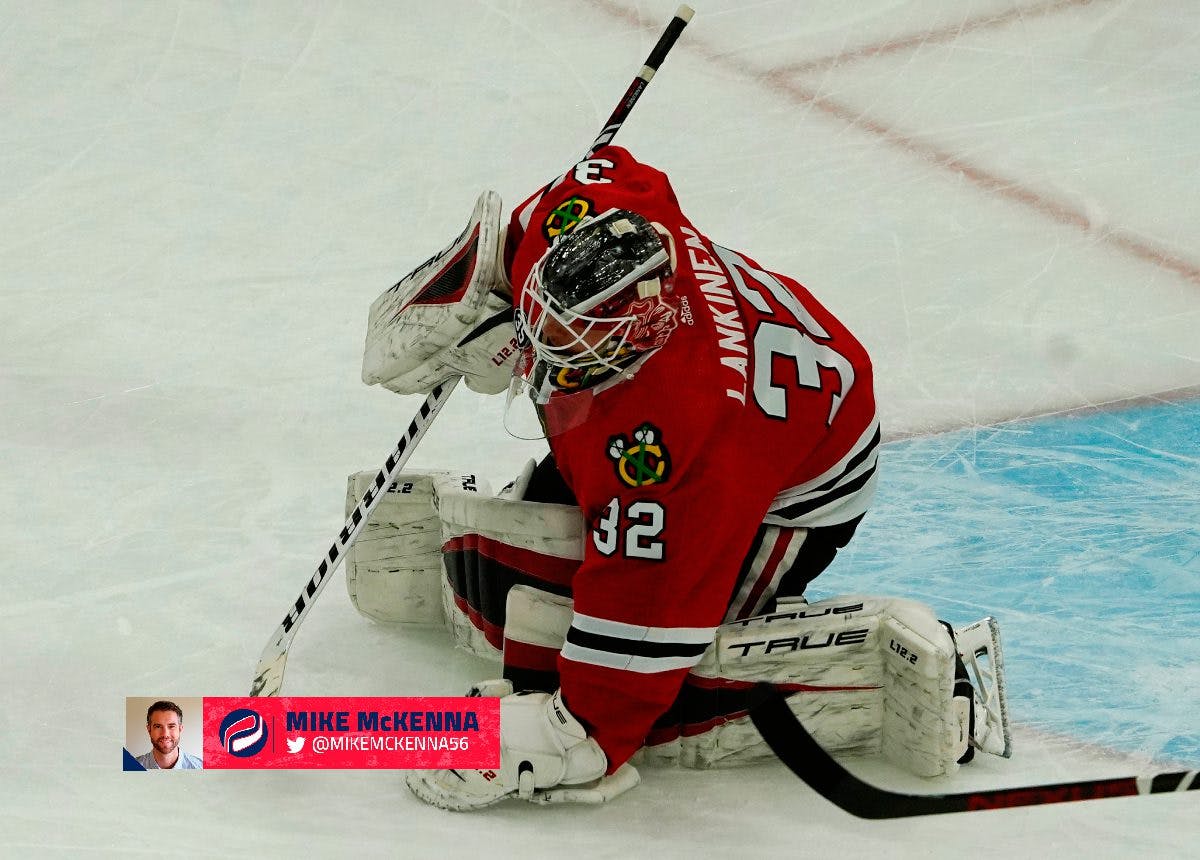Analysis: Two examples of goalie Kryptonite

Every night a few goals catch my eye, and it’s worth explaining them in detail. Here are two tallies cherry-picked from Monday night’s NHL games.
Sabres win 6-5 over Blackhawks after this wild goal with 10.6 seconds left
Why the shot went in:
An insane chain of events that no goaltender is prepared for. It’s a 5-5 tie with just over 10 seconds left in the third period. The Chicago Blackhawks have already blown a 4-0 lead. And Buffalo Sabres forward Tage Thompson breaks his stick on a one-timer attempt. Yet somehow, the puck bounces off the endboards, ricochets off Chicago goaltender Kevin Lankinen and into the net for the game-winning goal. Lankinen is so frustrated that he turns around and smashes his stick against the goal frame.
This was one of the crazier goals I’ve seen. But I also understand why Lankinen looked so out of sorts before the puck banked off of his skate and into the net. Here’s why from a goaltender’s perspective: when a player snaps a stick on a one-timer but still gets a portion of the puck, it’s like your goalie brain stops responding. It can’t compute what has just taken place. And sometimes there’s a stick flying in your direction. It’s really difficult to track the puck when multiple objects are hurtling towards you.
How the goal could have been prevented:
If Dylan Strome hadn’t taken a hooking penalty at the 18:51 minute mark of the third period, the Blackhawks wouldn’t have been short-handed to begin with. But despite Chicago being a man down, Thompson likely doesn’t score unless his stick breaks. Which seems crazy – but it’s true.
Lankinen was in a good position. If the one-timer had come through in a normal way, I think he would have made the save. But Lankinen got in trouble because he drifted forward. His feet were never set. Lankinen ended up well outside his crease and was forced to chase the play back to his post.
And that’s where things got wonky for Lankinen. Had his feet been set for Thompson’s shot, Lankinen would have remained within the blue paint. Lankinen could have easily rotated to his right and sealed off the near post. Instead, the Hawks goaltender was so far out of his net that he was forced to rotate to his left. The result was that Lankinen lost sight of the puck until it bounced off his skate and into the net.
It’s a frustrating end to a game the Blackhawks should have won. But it highlights a deficiency in Lankinen’s game: he’s overactive and struggles to stay within his crease.
Bottom line:
It was a tough play to read, but if Lankinen had gotten his feet set before the shot, he would have easily made the save when the puck caromed off the boards.
Vladi already?!
Why the shot went in:
A few things conspired against the Vancouver Canucks on this goal against. The most obvious being that St. Louis Blues winger Vladimir Tarasenko actually misses the net with the initial shot. But instead of the puck going wide, it hits the paddle of Canucks goaltender Jaroslav Halak, rebounding back onto Tarasenko’s blade. He’s then able to chip the rebound up and over Halak for his 500th NHL point.
But there’s more to it than Halak simply being beaten by a rebound: I think he was screened by his own Vancouver teammates. Luke Schenn and J.T. Miller were both occupying Halak’s sightline to Blues forward Pavel Buchnevich when he received the puck in the high slot from teammate Robert Thomas.
To me, that visual interference is a big reason why Halak was late arriving at his post for the initial Tarasenko shot. He wasn’t able to fully rotate in time and left the paddle of his goalie stick behind him. Halak was slow on the play to begin with and had to reach for the post with his left leg. He became spread and vulnerable – exactly why Tarasenko was able to score on the rebound. The Blues sniper had plenty of space on the short side.
How the goal could have been prevented:
The simple answer is that Halak needed to do a better job of connecting the dots through traffic. When the puck got to Buchnevich, Halak was low and wide in his stance. That’s not ideal for finding pucks in today’s game. And because Halak’s feet were so far spread apart in his stance, he had a hard time rotating his body and driving to the far post. He should have been more upright to begin with and fought harder to see the puck through traffic.
The Canucks also had three players in the slot that were capable of preventing a pass to Tarasenko. Whether it’s Schenn or Tanner Pearson up high, or Miller low, that pass simply cannot get through. And notice Vancouver’s defensemen: Quinn Hughes and Schenn were both above the hash marks. It’s disconcerting that J.T. Miller was the last line of defense all alone in front of the Canucks net.
Bottom line:
Vancouver got caught with its defensemen high in the defensive zone and failed to seal a passing lane. Halak was screened and unable able to connect the dots in time.
More from Mike McKenna
- Ranking every NHL goalie tandem for 2023-24
- Staring down Lou: How standing up for yourself can change a player’s career
- Why it’s time to embrace ‘gambles’ like the Jake Sanderson contract
- Why we shouldn’t view Sheldon Keefe’s contract extension as a vote of confidence
- ‘Two Sean O’Connors?’ NHL training camps bring the funny – and the weird